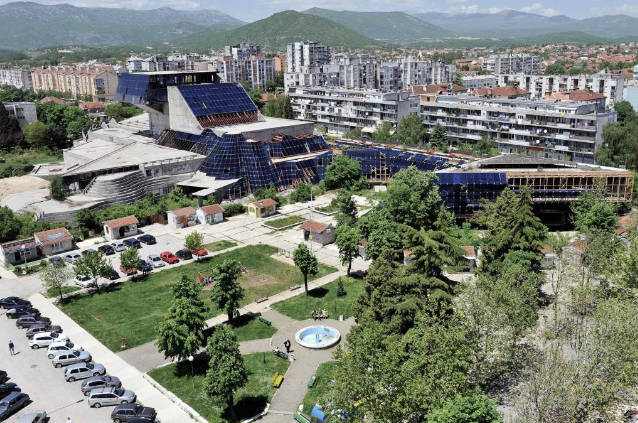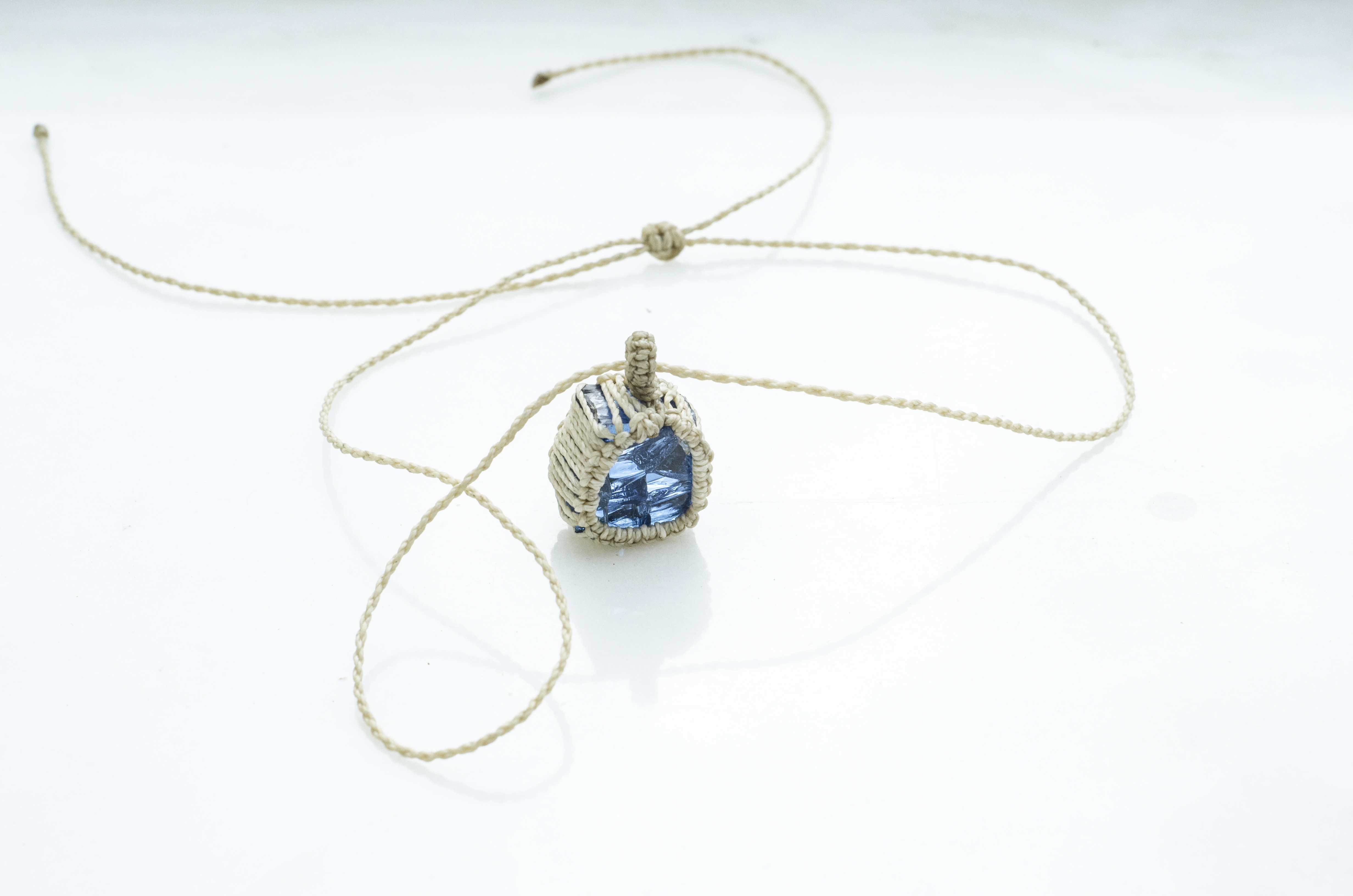<scroll down for english>
plavo staklo sa prozora Doma Revolucije Nikšić; nakit ručno izradili ulični prodavači nakita u Sao Paulu, Brazil, 2016.
“Sedamdesetih godina dvadesetog vijeka Dom revolucije u Nikšiću zamišljen je kao jedno od najmodernijih arhitektonskih zdanja tadašnje SFR Jugoslavije. Taj megalomanski projekat nikada nije završen i danas je jedno od najružnijih zdanja na tom istom prostoru, kao svjedok jednog davnog, neostvarenog mita. Vizuelno, ono što dominira tim zdanjem, je azurno plava boja stakla kojim je obložena gotovo cijela njegova površina. Adrijana Gvozdenović je od komadića tog stakla napravila seriju radova pod nazivom ,,Amajlija za kulturne radnike’’. Riječ je o nakitu – ogrlice, narukvice, koje su ručno izradili ulični prodavci nakita u Sao Paolu u Brazilu. Imitirajući savremene odnose umjetničkog tržišta, gdje je precizno definisan hijerarhijski poredak na osnovi nadređenosti – podređenosti, ona je iskoristila ulične proizvođače nakita, da realizuju njenu ideju i dovedu je do konačnog proizvoda. Polazište za ovaj rad umjetnica nalazi u vlastitom sjećanju ali i kolektivnoj memoriji koja se bazira na osjećaju nostalgije za prošlošću kao i snažnim utiscima djelovanja jedne moćne ideologije i njenih sistema. Plavo staklo kao sugestija amajlije, jedinstvene energije koju taj predmet nosi u sebi, ovdje je dobro odabran materijal koji svojim artističkim atributima emanira tu vrstu promišljanja, u smislu njegovog simboličkog i asocijativnog značenja. Autorka se ovdje bavi preispitivanjem i ponovnim isčitavanjem jedne sveobuhvatne ideje i cjelokupnog duha protekle epohe koja je počivala na ideološkim, sociološkim, filozofskim uvjerenjima njenih protagonista, a u kontekstu današnjih, aktulenih sistema vrijednosti, društvenih i istorijskih okolnosti. Tako nakit izrađen od ovih djelića stakla, dobija jednu sasvim drugačiju, gotovo paradoksalnu dimenziju – poprima taj ideološki sakralni karakter, iz razloga njegovog nekadašnjeg pripadanja zamišljenom hramu Revolucije, čime se, i značenjski i formalno, uspostavlja njihova uzajamnost.”
– Milica Bezmarević (iz kataloga izložbe Art Factory)
blue glass from the ruins of the Home of Revolution in Nikšić, used for jewelry handmade by street sellers in Sao Paulo, Brazil, 2016.
“In the seventies of the twentieth century, the Home of the Revolution in Niksic was conceived as one of the most modern architectural buildings of the then SFR Yugoslavia. This megalomaniac the project has never been completed and today it is one of the most rugged buildings on that in the same area, as a witness to a long ago, unfulfilled myth. Visually, what dominate on this building, is an azure-blue colour of the glass, coated almost entirely on its surface. Adrijana Gvozdenovic made from the pieces of that glass a series of works called “Amulet for Cultural Workers”. It’s jewellery – necklaces, bracelets, hand-made by street jewellery sellers in Sao Paolo, Brazil. Imitating the contemporary relations of the art market, where it is precisely defined hierarchically order on the basis of superiority – subordination, she used the street jewellery manufacturers, to realise her idea and bring it to the final product. The starting point for this work the artist finds in her own memory but also in the collective memory based on a sense of nostalgia for the past, as well as strong impressions of one powerful ideology and its systems. Blue glass as a suggestion of amulet, the unique energy that this object carries in it, here is a well-chosen material that emanates this type of reflection with its artistic attributes, in terms of its symbolic and associative meaning. The author here deals with the re-examination and re-reading of a comprehensive idea and the overall spirit of the past era based on the ideological, sociological and philosophical beliefs of its protagonists, in the context of today’s realistic system of values, social and historical circumstances. Thus the jewellery made of these pieces of glass gets a completely different, almost paradoxical dimension – it takes on this ideological sacral character because of its former affiliation to the imaginary temple of the Revolution, which, both meaningfully and formally, establishes their reciprocity. “
– Milica Bezmarević (from the catalogue of the exhibition Art Factory, free translation by Adrijana Gvozdenović)




